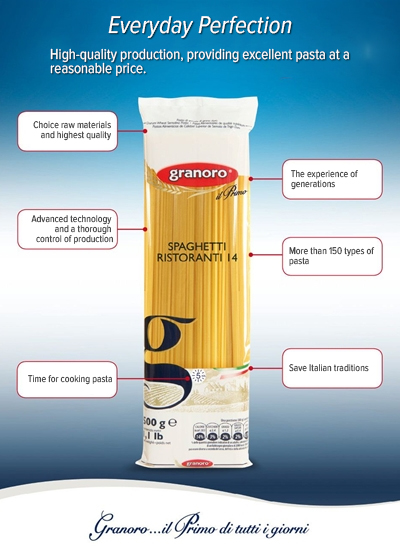
The result is high-quality Italian pasta that has an intense colour and smell, typical of sun-kissed durum wheat, the “right thickness” and a balanced and uniform cooking time.
Thanks to the careful selection of fine semolina with a high protein content and the production skills of Attilio and his family, Granoro pasta remains elastic and with a good consistency for many hours after cooking and the surface is never coated with a starchy film.
The high quality of Granoro pasta derives from the careful selection of durum wheat semolina, good quality gluten and production expertise, in particular during the kneading and drying stages. The quality of Granoro pasta can be seen in the way it doubles in volume when cooked, as the surface of every piece of pasta has a distinctive porosity allowing it to absorb water during the cooking process. It also cooks perfectly because it cooks evenly from the outside in and doesn’t lose starch in the cooking water, which is left clear and free of residues.
You Can Tell When It’S Granoro.
The high quality of Granoro pasta is the result of passion, care and the attention paid throughout the entire production process, which successfully combines the ancient tradition of pasta making with modern production technology.
Granoro produces high-quality pasta, selecting and using only the best raw materials on the market in its production process. It uses high-quality durum wheat semolina purchased from mills located exclusively in Puglia, selected in accordance with strict quality standards and carefully analysed during the acceptance stage by its own in-house analysis laboratory.
Ogni singolo formato di pasta ha la sua specifica trafila e in Granoro sono realizzate su progetti del Sig. Attilio, affinchè ogni formato in base alla sua grandezza e forma abbia lo spessore più indicato per un tempo di cottura adeguato e giusto.
Drying is the most important stage in the pasta production process, because it is such a delicate one. Pasta has a high water content after extrusion and once the drying process has been completed, the humidity value must not exceed 12.5%, which is the maximum value set forth by the applicable regulations.
Granoro pasta, produced using carefully selected semolina, contains a high amount of protein, in particular gluten, a viscoelastic compound with a reticular structure, obtained from the combination of two protein fractions, gliadins and glutenins.
The toughness and quality of Granoro pasta are the result of the careful selection of durum wheat semolina, skilful production processes and extrusion thicknesses calculated to obtain appropriate and balanced cooking times.
Attilio Mastromauro has always been convinced that the art of a true pasta maker is to produce pasta with the right balance between thickness and cooking time.
The quality of the raw materials and the special production process designed by Attilio Mastromauro give Granoro pasta the right degree of porosity, resulting in high water absorption during the cooking process.
Pasta is rich in important nutritional elements and is easily digestible. However, to preserve those characteristics it must cook evenly from the outside in, without leaving any parts uncooked and must not lose its nutritional substances in the water whilst cooking.